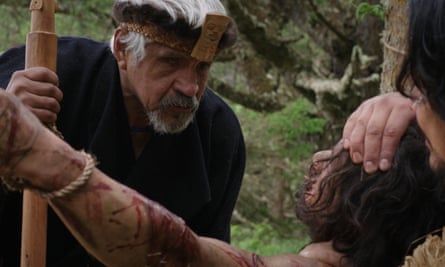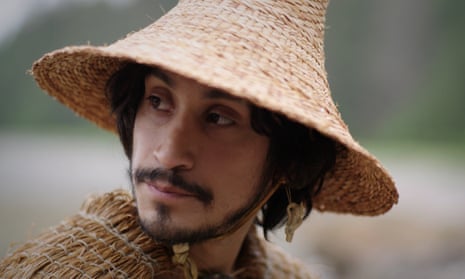Plenty of films are somewhat incomprehensible, but a forthcoming movie is in a language that only about 20 people in the world can speak fluently.
With subtitles, audiences will be able to understand a feature film titled SGaawaay K’uuna, translated as Edge of the Knife, which has its UK premiere in April.
It is in two dialects of the highly endangered Haida language, the ancestral tongue of the Haida people of British Columbia. It is unrelated to any other language, and actors had to learn it to understand their lines.
The film is playing an important role in preserving the language, its director Gwaai Edenshaw said. He told the Guardian: “I know that, if our language is this far gone, statistically it’s supposed to be over. But that’s not something that we’re willing to accept.”
The Haida are an Indigenous First Nations community whose traditional territory is Haida Gwaii (formerly Queen Charlotte Islands), an archipelago of forested islands off the west coast of Canada.
Edenshaw said most of the fluent Haida speakers were in his Haida Gwaii homeland. “There’s a smattering off the island [who] also speak it.” Edenshaw himself speaks some of the language but is not fluent, having been taught at school in English.

He added that the community generally lives off the sea and makes dugout canoes and houses from local red cedars. Noting that their numbers were ravaged by smallpox and other diseases in the 19th century, he said a former population of tens of thousands has dwindled to a few thousand today.
The few Haida speakers are extremely concerned about the language’s future and were very enthusiastic about the film, he said. “We had to rely heavily upon the elders for the translation. We wrote it in English.”
More than 70 local people worked on the production, with Haida speakers taking incidental roles, weavers creating the costumes and other craftspeople making props.
The film, set on Haida Gwaii in the 19th century, is based on an old Haida myth about a man who survives an accident at sea, only to become so weakened that he is taken over by supernatural beings.
It is part of a wider push to preserve the Haida language, including a new dictionary and recordings of local voices.

Edenshaw said Haida uses a lot of “guttural sounds and glottal stops” and that actors needed to learn it because it differs from English, let alone other languages: “When you upspeak to denote a question in English, that doesn’t exist in Haida. There is an upspeak, but the questioning portion … appears in the middle of the sentence.”
That was among the details that his cast of non-Haida speakers had to learn over many months before the shoot.
2019 is Unesco’s Year of Indigenous Languages, “to preserve, support and promote” them worldwide.
Mark Turin, associate professor of anthropology at the University of British Columbia and a specialist in endangered languages, told the Guardian that about half of up to 7,100 languages worldwide were “severely endangered” and would likely cease to be used as everyday vernaculars by the end of this century unless action is taken.
He said colonialism had historically taken its toll on indigenous languages, with some communities actively prevented from speaking them.
“One of the enduring horrors of British colonialism is the conviction that one language – English – would be suitable for all interactions and activities. Colonisation resulted in the intergenerational transmission of language effectively breaking down. It’s far harder to relearn a language after you have stopped speaking it.”
He pointed to recent research that shows a correlation between indigenous language sustainability and decreased youth suicide within indigenous communities: “Speaking your indigenous language is not just learning French in school. It has public health implications.”
He observed that Haida is among languages that have been “pushed almost to the edge” and that, while numerous indigenous communities worldwide are trying to revive their language, the Haida people have taken a particularly innovative approach. “This film – which I’ve watched and loved – has done something that I don’t think I’ve ever seen before, using a feature movie as a process of language revitalisation … It’s a hugely creative and powerful commitment for the community to have made,” he said.
The UK premiere is part of the Canada Now film festival, showcasing new Canadian cinema, at the Curzon Soho, London, from 24 to 28 April.
